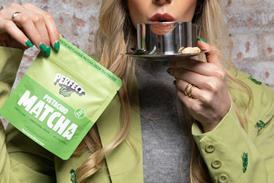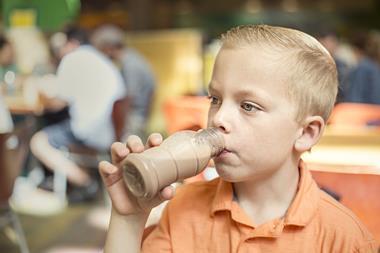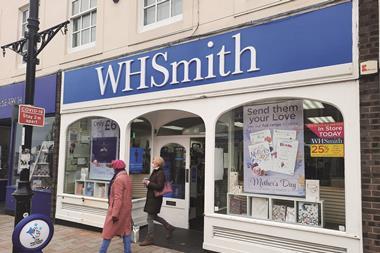While Dutch retailer Ahold struggles to rescue its reputation after profit warnings, financial irregularities and the resignation last week of cheif executive officer Cees van der Hoeven and chief financial officer Michael Meurs, one small part of its operation is shining like a beacon among the dark clouds.
This year the company wants to double the number of convenience stores it has in its homeland. Granted, the convenience format is just a pinprick in Ahold's E66.6bn empire a mere 32 stores out of a 9,000 strong estate across 27 countries but convenience, and its accompanying foodservice element, is proving a winner for the supermarket giant.
AH To Go is part of the E6bn Albert Heijn operation which, with its 666 stores and 28% market share, is the market leader in food retail in the Netherlands. The first outlet opened in January last year in Rotterdam and was followed by a second pilot store in Amsterdam. In February 2002 the first AH To Go on a forecourt opened in Bussum in the central Netherlands as part of a joint venture with Esso.
According to Albert Heijn concept development manager Robert van Houten, the retailer is targeting high traffic sites in busy city centres, petrol stations, railway stations and hospitals. The design, layout, product and services at AH To Go are geared to grab and go, with space to give customers the freedom to move easily and lots of stainless steel, glass and wood to make the store transparent and open.
"It is more like foodservice than food retail," says van Houten.
The idea is to provide a quick solution for anyone on the move and the store is divided into two main areas: food for now fresh products for direct consumption or food for later in the form of meal solutions for home (within 16 hours). Van Houten describes the former as "fast lane service" while food for later is located at the back of the store and is the "slower lane". The theme behind food for now is "excellent street food". Van Houten says the idea is to compete with the likes of Burger King and the proposition satisfies breakfast, lunch and healthy snack demand.
Among the innovative ideas are candy fashionables' small pieces of fresh vegetables that are proving especially popular with female customers. The product is sold in plastic packaging that looks like a see-through cone. Another clever idea, stolen from McDonald's, is the salad shaker salad onto which you pour the dressing and shake.
There are two distinct areas in food for now: grab-and-go and the cockpit. The grab-and-go fixture contains five product offers: sandwiches (traditional sandwiches, wraps and flat breads); drinks (juices, smoothies and soft drinks); snacks (tapas and sushi); salads and veg (salad shakers, candy' veg and fruit cups; and dairy (yogurts).
The cockpit area comprises a cold and hot counter. Sandwiches and snacks are prepared in front of the consumer and there is a self-service element.
Food for later is based around meal solutions, with a strong emphasis on new products. It is divided into three components: ready to cook, with produce like vegetables, ready to heat and fresh pizza.
The development of AH To Go is part of a strategy to get closer to foodservice activities. In The Netherlands foodservice already has one-third of the market and in 15 years it will be level with retail.
"Dutch consumers only take an average of 19 minutes in the kitchen to prepare a meal," says van Houten. "And there has been a 33% increase in sales of ready meals in the last two years. People are outsourcing things they don't want to do, like cooking."
Albert Heijn has therefore also put a convenience offer into its other store formats: local, conventional and superstores.
The first Local store is in The Hague, with an emphasis on food to go and on fresh products, which are merchandised on dominant islands in the middle of the store.
In conventional stores the convenience offer focuses on fresh ready meals, fresh pizza and salad bars, stir fry and rotisserie. The Traiteur department prepares fresh meals in front of the customer and is designed to compete with pizzeria, take away bars and Chinese restaurants.
The Albert Heijn XL superstore, designed by UK company Conran Design Group, also contains a Traiteur section with a wider variety of ready to eat solutions as well as a juice bar and coffee area.
{{ANALYSIS }}
This year the company wants to double the number of convenience stores it has in its homeland. Granted, the convenience format is just a pinprick in Ahold's E66.6bn empire a mere 32 stores out of a 9,000 strong estate across 27 countries but convenience, and its accompanying foodservice element, is proving a winner for the supermarket giant.
AH To Go is part of the E6bn Albert Heijn operation which, with its 666 stores and 28% market share, is the market leader in food retail in the Netherlands. The first outlet opened in January last year in Rotterdam and was followed by a second pilot store in Amsterdam. In February 2002 the first AH To Go on a forecourt opened in Bussum in the central Netherlands as part of a joint venture with Esso.
According to Albert Heijn concept development manager Robert van Houten, the retailer is targeting high traffic sites in busy city centres, petrol stations, railway stations and hospitals. The design, layout, product and services at AH To Go are geared to grab and go, with space to give customers the freedom to move easily and lots of stainless steel, glass and wood to make the store transparent and open.
"It is more like foodservice than food retail," says van Houten.
The idea is to provide a quick solution for anyone on the move and the store is divided into two main areas: food for now fresh products for direct consumption or food for later in the form of meal solutions for home (within 16 hours). Van Houten describes the former as "fast lane service" while food for later is located at the back of the store and is the "slower lane". The theme behind food for now is "excellent street food". Van Houten says the idea is to compete with the likes of Burger King and the proposition satisfies breakfast, lunch and healthy snack demand.
Among the innovative ideas are candy fashionables' small pieces of fresh vegetables that are proving especially popular with female customers. The product is sold in plastic packaging that looks like a see-through cone. Another clever idea, stolen from McDonald's, is the salad shaker salad onto which you pour the dressing and shake.
There are two distinct areas in food for now: grab-and-go and the cockpit. The grab-and-go fixture contains five product offers: sandwiches (traditional sandwiches, wraps and flat breads); drinks (juices, smoothies and soft drinks); snacks (tapas and sushi); salads and veg (salad shakers, candy' veg and fruit cups; and dairy (yogurts).
The cockpit area comprises a cold and hot counter. Sandwiches and snacks are prepared in front of the consumer and there is a self-service element.
Food for later is based around meal solutions, with a strong emphasis on new products. It is divided into three components: ready to cook, with produce like vegetables, ready to heat and fresh pizza.
The development of AH To Go is part of a strategy to get closer to foodservice activities. In The Netherlands foodservice already has one-third of the market and in 15 years it will be level with retail.
"Dutch consumers only take an average of 19 minutes in the kitchen to prepare a meal," says van Houten. "And there has been a 33% increase in sales of ready meals in the last two years. People are outsourcing things they don't want to do, like cooking."
Albert Heijn has therefore also put a convenience offer into its other store formats: local, conventional and superstores.
The first Local store is in The Hague, with an emphasis on food to go and on fresh products, which are merchandised on dominant islands in the middle of the store.
In conventional stores the convenience offer focuses on fresh ready meals, fresh pizza and salad bars, stir fry and rotisserie. The Traiteur department prepares fresh meals in front of the customer and is designed to compete with pizzeria, take away bars and Chinese restaurants.
The Albert Heijn XL superstore, designed by UK company Conran Design Group, also contains a Traiteur section with a wider variety of ready to eat solutions as well as a juice bar and coffee area.
{{ANALYSIS }}















No comments yet